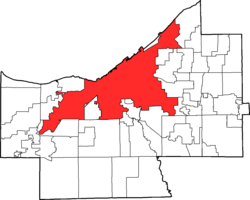Cleveland Division of Police
| Cleveland Division of Police | |
|---|---|
| Abbreviation | CDP |

Shoulder sleeve patch for patrol officers.
|
|
| Motto | To protect and serve |
| Agency overview | |
| Formed | 1868 |
| Employees | 1,709 (2012) |
| Legal personality | Governmental: Government agency |
| Jurisdictional structure | |
| Operations jurisdiction* | City of Cleveland in the state of Ohio, US |
 |
|
| Jurisdiction of the Cleveland Division of Police | |
| Size | 82.47 sq mi (213.6 km²) |
| Population | 393,781 (2012) |
| Legal jurisdiction | City of Cleveland |
| Governing body | Cleveland Department of Public Safety |
| General nature | |
| Operational structure | |
| Headquarters | 1300 Ontario Street Cleveland, Ohio, U.S |
| Officers | 1,550 (2014) |
| Unsworn members | 228 (2012) |
| Elected officer responsible | Michael McGrath, Director |
| Agency executive | Calvin Williams, Chief of Police |
| Operations |
4
|
| Facilities | |
| Districts |
5
|
| Website | |
| Division of Police | |
| Footnotes | |
| * Divisional agency: Division of the country, over which the agency has usual operational jurisdiction. | |
The Cleveland Division of Police is the governmental agency responsible for law enforcement in the city of Cleveland, Ohio. Michael McGrath was the chief of police since 2005 and then became the Safety Service Director on February 10, 2014 when Calvin Williams was appointed Chief of Police.
Prior to 1850, the preservation of the peace was left to an elected city marshal who was assisted by a number of constables and night watchmen. Concerns over the adequacy of this arrangement had led, in 1837, to the formation of the Cleveland Grays, a private military company, for the partial stated purpose of assisting local law enforcement when and if the need arose. In 1850, city council formally appointed the first night watch. In 1866, under enabling legislation passed by the Ohio General Assembly called the Metropolitan Police Act, the Cleveland Police Department was formed, headed by a board of police commissioners tasked with the job of appointing a superintendent of police as well as a number of patrol officers.
The department's early years were not without challenge and it underwent two reorganizations prior to 1893. By the end of the century, however, the climate had begun to calm and the city saw improvements in service. The department had begun to innovate by adopting a callbox system, beginning the use of police wagons, and forming a mounted unit. In 1903, the department took on its current form when the General Assembly repealed the Metropolitan Police Act and the responsibility for the formation and control of the department was given to the city.
From the early 1900s to the start of World War II, the department concentrated on managing the city's rapid growth. Cleveland was rapidly growing, even through the Great Depression, with the population increasing from 380,000 in 1900, to more than 830,000 by the 1920s. The police department grew with the city, growing from less than 400 officers in 1900, to more than 1,300 by 1920. When legendary Prohibition-era crimefighter Eliot Ness became director of public safety in 1935, he abolished the existing system of precincts and reorganized the city into police districts, with each commanded by a captain. Ness's system is still in use today. Under Ness, the Division of Police has experimented with new technologies and procedures, gaining a reputation as one of the most progressive and efficient departments in the nation.
...
Wikipedia
